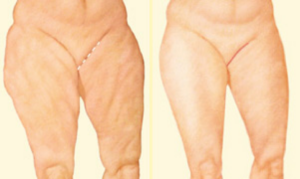
Thigh Lift
A thigh lift reshapes the thighs by reducing excess skin, and in some cases fat, resulting in smoother skin and better-proportioned contours of the thighs and lower body.
Beauty for life
Enhancing your appearance with a thigh lift
If fitness and weight loss efforts have not achieved your goals for a body that is firmer, more youthful-looking and more proportionate to your overall body image, a surgical thigh lift may be right for you.
This surgery reshapes the thighs by reducing excess skin, and in some cases fat, resulting in smoother skin and better-proportioned contours of the thighs and lower body.
Is it right for me?
Candidates for thigh lift are:
- People whose weight is relatively stable
Individuals with excess soft tissue along the inner or medial thigh region and/or the outer thigh - Healthy individuals who do not have medical conditions that can impair healing or increase risk of surgery
- Non-smokers
- Individuals with a positive outlook and realistic goals for what thigh lift surgery can accomplish
- Individuals committed to leading a healthy lifestyle including proper nutrition and fitness
What it won’t do: Thigh lifts are not intended strictly for the removal of excess fat. Liposuction alone can remove excess fat deposits where skin has good elasticity and is able to naturally conform to new body contours. In cases where skin elasticity is poor, a combination of liposuction and thigh lift techniques may be recommended.
WHAT TO EXPECT DURING YOUR CONSULTATION
The success and safety of your thigh lift procedure depends very much on your complete candidness during your consultation. You’ll be asked a number of questions about your health, desires and lifestyle.
Be prepared to discuss:
- The options available in thigh lift surgery
- Medical conditions, drug allergies and medical treatments
- Use of current medications, vitamins, herbal supplements, alcohol, tobacco and drugs
Previous surgeries
PREPARING FOR SURGERY
Prior to surgery, you may be asked to:
- Get lab testing or medical evaluation
- Take certain medications or adjust your current medications
- Stop smoking well in advance of surgery
- Avoid taking aspirin, anti-inflammatory drugs and herbal supplements as they can increase bleeding
Special instructions you receive will cover:
- What to do on the day of surgery
- The use of anesthesia during your thigh lift
- Post-operative care and follow-up
Your plastic surgeon will also discuss where your procedure will be performed. Thigh lift surgery may be performed in an accredited office-based surgical center, outpatient of ambulatory surgical center, or a hospital.
PROCEDURAL STEPS:
What happens during thigh lift surgery?
Step 1 – Anesthesia
Medications are administered for your comfort during the surgical procedures. The choices include intravenous sedation and general anesthesia. Your doctor will recommend the best choice for you.
Step 2 – The incision
Incision patterns vary based on the area or areas to be treated, degree of correction and patient and surgeon preference.
One common technique used for a thigh lift places incisions in the groin, extending downward wrapping around the back of the thigh. The underlying tissue matrix will be reshaped and tightened, and skin will be reduced and redraped resulting in more proportionate and smoother body contours.
You may qualify for a minimal incision medial thigh lift which involves an incision only in the groin area. Your surgeon will determine what’s appropriate.
IMPORTANT FACTS ABOUT THE SAFETY AND RISKS OF THIGH LIFT SURGERY
The decision to have thigh lift surgery is extremely personal and you’ll have to decide if the benefits will achieve your goals and if the risks and potential complications are acceptable.
Your plastic surgeon and/or staff will explain in detail the risks associated with surgery. You will be asked to sign consent forms to ensure that you fully understand the procedure you will undergo and any risks and potential complications.
Possible risks of thigh lift surgery include:
- Unfavorable scarring
- Bleeding (hematoma)
- Infection
- Fluid accumulation
- Poor wound healing
- Skin loss
- Blood clots
- Numbness or other changes in skin sensation
- Anesthesia risks
- Skin discoloration and/or swelling
- Fatty tissue found deep in the skin might die (fat necrosis)
- Major wound separation Asymmetry
- Pain, which may persist Unsatisfactory results such as highly visible surgical scar location, unacceptable visible deformities, bunching and rippling in the skin near the suture lines or at the ends of the incisions
- Deep vein thrombosis, cardiac and pulmonary complications
- Recurrent looseness of skin
- Sutures may spontaneously surface through the skin, become visible or produce irritation that require removal
- Possibility of revisional surgery
Medial Thigh Lift

Improving the contours of the outer thigh may require an incision extending from the groin around the hip.
Through these incisions your plastic surgeon will tighten tissues for a smoother, better-toned lower body contour.
Advanced techniques usually allow incisions to be placed in strategic locations where they can be hidden by most types of clothing and swimsuits. However, incisions may be extensive.
Outer Thigh Lift

Step 3 – Closing the incisions
Step 3 – Closing the incisions Deep support sutures within underlying tissues help to form the newly shaped contours. Sutures close the skin incisions.
MY RECOVERY
When your procedure is completed, dressing or bandages may be applied to your incisions, and you may be wrapped in an elastic bandage or a compression garment to minimize swelling and to support your new contours as you heal.
One or more small, thin tubes may be temporarily placed under the skin to drain excess fluid or blood that may collect.
You will be given specific instructions that may include: How to care for the surgical site(s) following surgery, medications to apply or take orally to aid healing and reduce the risk of infection, specific concerns to look for at the surgical site or in your general health, and when to follow-up with your plastic surgeon.
THE RESULTS WILL BE LONG-LASTING
The results of a thigh lift are visible almost immediately. However, it may take several months for the final results to fully develop.
Some visible scars will remain, but the overall results are long lasting, provided that you maintain a stable weight and general fitness.
As your body ages, it is natural to lose some firmness. However, most of your initial improvement should be relatively permanent.
HOW MUCH WILL THIGH LIFT SURGERY COST?
Cost is always a consideration in elective surgery. Prices for thigh lifts can vary widely. A surgeon’s cost for thigh lift surgery may vary based on his or her experience as well as geographic office location.
Many plastic surgeons offer patient financing plans, so be sure to ask.
Cost may include:
- Surgeon’s fee
- Hospital or surgical facility costs
- Anesthesia fees
- Prescriptions for medication
- Post-surgery garments
Medical tests
Your satisfaction involves more than a fee
When choosing a plastic surgeon for a thigh lift, remember that the surgeon’s experience and your comfort with him or her are just as important as the final cost of the surgery. Most health insurance does not cover cosmetic surgery or its complications.
WORDS TO KNOW
- General anesthesia: Drugs and/or gases used during an operation to relieve pain and alter consciousness.
- Hematoma: Blood pooling beneath the skin.
Intravenous sedation: Sedatives administered by injection into a vein to help you relax. - Liposuction: Also called lipoplasty or suction lipectomy, this procedure vacuums out fat from beneath the skin’s surface to reduce fullness.
- Local anesthesia: A drug injected directly to the site of an incision during an operation to relieve pain.
- Medial thigh lift: A surgical procedure to correct sagging of the inner thigh.
- Outer thigh lift: A surgical procedure to correct sagging of the outer and mid-thigh.
- Sutures: Stitches used by surgeons to hold skin and tissue together.

